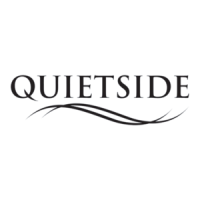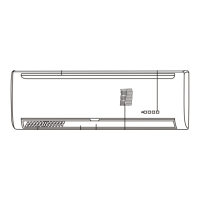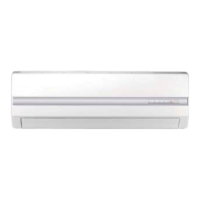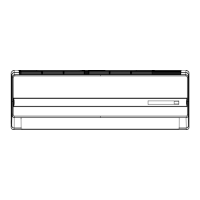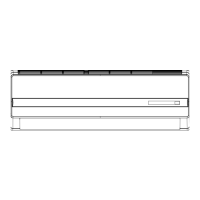Do you have a question about the Quietside QSCC-123 and is the answer not in the manual?
Note regarding the appliance's intended use and supervision requirements for children and infirm persons.
Guidance on professional installation and safety checks for installation like grounding.
Safety precautions and guidelines for operating the air conditioner, avoiding hazards.
Details on air return grid, airflow direction fins, outlet, filter, and drain tube.
Identification of air inlet and discharge vents on the outdoor unit.
How to open, close the front panel, and use the emergency operation key.
Descriptions of running, sleeping, timer, and remote signal receiver indicators.
Explanation of buttons like ON/OFF, MODE, FAN SPEED, TIMER, SLEEP, TURBO, HOLD, LAMP.
How the remote controller sends signals to the air conditioner unit for operation.
Steps for choosing modes like AUTO, COOL, DRY, HEAT, FAN and setting temperature.
How to activate and deactivate the turbo cooling/heating function for maximum output.
Methods for manually or automatically adjusting airflow direction (left/right, up/down).
Instructions for setting the timer to turn the unit on or off automatically.
How to use sleep mode to reduce noise and adjust temperature automatically.
Procedures for replacing batteries in the remote controller when signal is weak.
Explanation of heat pump principles and the automatic defrosting function.
Checks and actions before the operating season begins, like blocking materials and grounding.
Routine checks and cleaning during the operating season, focusing on air filters.
Steps for maintenance after the operating season ends, including drying and cleaning.
Common checks for when the air conditioner does not operate, e.g., power, time settings.
Checks for poor cooling or heating performance, e.g., filters, room settings.
Situations requiring immediate contact with a professional contractor, e.g., fuse breaks.
Explanation of the 3-minute restart protection timer for compressor safety.
Reasons for air not blowing or stopping during different modes like heating or drying.
Explanations for cracking noise, remote signal issues, and moisture on grilles.
Key points to consider before and during electrical connections, like voltage and wire types.
Specific wiring diagrams for connecting the outdoor unit to power and indoor unit.
Details on wire gauge, number of wires, and connection types for interconnecting units.
Instructions for connecting the defrost sensor for heat pump models between units.
Notes for qualified HVAC contractors regarding manual use, assistance, and warranty.
Critical safety instructions, warnings, and danger symbols for installation and operation.
List of items the installer must supply for installation, like line sets and wiring.
Room types like Server, Office, Residential, with sizing and specific needs.
Best placement for indoor/outdoor units considering airflow, clearance, and environment.
Description of the microprocessor controller, remote communication, and sensors.
Information on optional components like Low Ambient Controller and Condensate Pump.
Steps for removing units from packaging and locating the indoor unit with clearances.
Instructions for drilling the wall penetration for piping, wiring, and defrost sensor.
How to securely install the indoor unit's mounting bracket to the wall.
Preparing refrigerant lines, condensate hose, and wiring for indoor unit connection.
Securing the indoor unit onto the installed mounting bracket, ensuring plumbness.
Guidelines for locating and positioning the outdoor unit with required clearances.
Procedures for connecting and running insulated refrigerant lines between units.
Process for evacuating the refrigerant system to remove moisture using vacuum gauges.
Guidelines for connecting the main power supply, breaker sizing, and grounding.
Instructions for connecting control wires between indoor and outdoor units, including safety.
How to connect and route the condensate drain hose for proper drainage.
Conditions and steps for starting the unit in cooling mode, including refrigerant release.
Conditions and steps for starting the unit in heat pump mode, including refrigerant release.
Electrical schematic for QSCC-093 and QSCC-123 models.
Electrical schematic for QSCC-183 and QSCC-243 models.
Detailed circuit diagram for the QSCE-093 model.
Detailed circuit diagram for the QSCE-123 model.
Detailed circuit diagram for the QSCE-183 model.
Detailed circuit diagram for the QSCE-243 model.
Note regarding the appliance's intended use and supervision requirements for children and infirm persons.
Guidance on professional installation and safety checks for installation like grounding.
Safety precautions and guidelines for operating the air conditioner, avoiding hazards.
Details on air return grid, airflow direction fins, outlet, filter, and drain tube.
Identification of air inlet and discharge vents on the outdoor unit.
How to open, close the front panel, and use the emergency operation key.
Descriptions of running, sleeping, timer, and remote signal receiver indicators.
Explanation of buttons like ON/OFF, MODE, FAN SPEED, TIMER, SLEEP, TURBO, HOLD, LAMP.
How the remote controller sends signals to the air conditioner unit for operation.
Steps for choosing modes like AUTO, COOL, DRY, HEAT, FAN and setting temperature.
How to activate and deactivate the turbo cooling/heating function for maximum output.
Methods for manually or automatically adjusting airflow direction (left/right, up/down).
Instructions for setting the timer to turn the unit on or off automatically.
How to use sleep mode to reduce noise and adjust temperature automatically.
Procedures for replacing batteries in the remote controller when signal is weak.
Explanation of heat pump principles and the automatic defrosting function.
Checks and actions before the operating season begins, like blocking materials and grounding.
Routine checks and cleaning during the operating season, focusing on air filters.
Steps for maintenance after the operating season ends, including drying and cleaning.
Common checks for when the air conditioner does not operate, e.g., power, time settings.
Checks for poor cooling or heating performance, e.g., filters, room settings.
Situations requiring immediate contact with a professional contractor, e.g., fuse breaks.
Explanation of the 3-minute restart protection timer for compressor safety.
Reasons for air not blowing or stopping during different modes like heating or drying.
Explanations for cracking noise, remote signal issues, and moisture on grilles.
Key points to consider before and during electrical connections, like voltage and wire types.
Specific wiring diagrams for connecting the outdoor unit to power and indoor unit.
Details on wire gauge, number of wires, and connection types for interconnecting units.
Instructions for connecting the defrost sensor for heat pump models between units.
Notes for qualified HVAC contractors regarding manual use, assistance, and warranty.
Critical safety instructions, warnings, and danger symbols for installation and operation.
List of items the installer must supply for installation, like line sets and wiring.
Room types like Server, Office, Residential, with sizing and specific needs.
Best placement for indoor/outdoor units considering airflow, clearance, and environment.
Description of the microprocessor controller, remote communication, and sensors.
Information on optional components like Low Ambient Controller and Condensate Pump.
Steps for removing units from packaging and locating the indoor unit with clearances.
Instructions for drilling the wall penetration for piping, wiring, and defrost sensor.
How to securely install the indoor unit's mounting bracket to the wall.
Preparing refrigerant lines, condensate hose, and wiring for indoor unit connection.
Securing the indoor unit onto the installed mounting bracket, ensuring plumbness.
Guidelines for locating and positioning the outdoor unit with required clearances.
Procedures for connecting and running insulated refrigerant lines between units.
Process for evacuating the refrigerant system to remove moisture using vacuum gauges.
Guidelines for connecting the main power supply, breaker sizing, and grounding.
Instructions for connecting control wires between indoor and outdoor units, including safety.
How to connect and route the condensate drain hose for proper drainage.
Conditions and steps for starting the unit in cooling mode, including refrigerant release.
Conditions and steps for starting the unit in heat pump mode, including refrigerant release.
Electrical schematic for QSCC-093 and QSCC-123 models.
Electrical schematic for QSCC-183 and QSCC-243 models.
Detailed circuit diagram for the QSCE-093 model.
Detailed circuit diagram for the QSCE-123 model.
Detailed circuit diagram for the QSCE-183 model.
Detailed circuit diagram for the QSCE-243 model.
| Brand | Quietside |
|---|---|
| Model | QSCC-123 |
| Category | Air Conditioner |
| Language | English |
